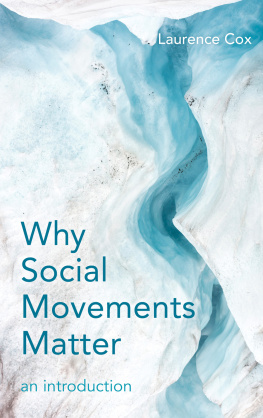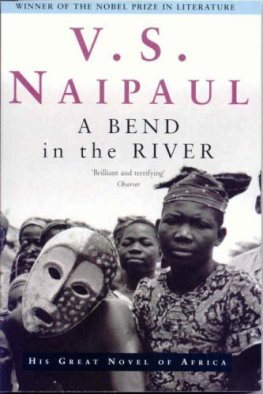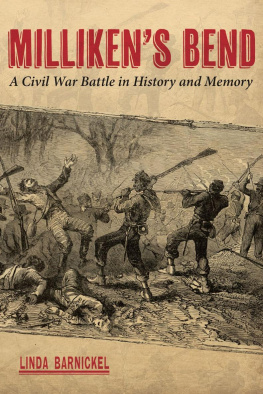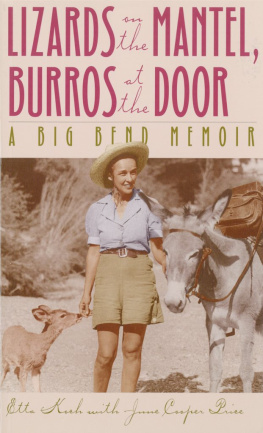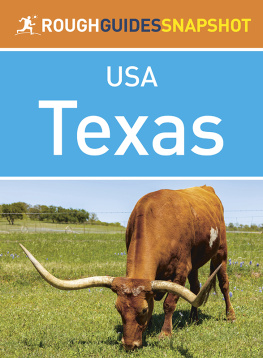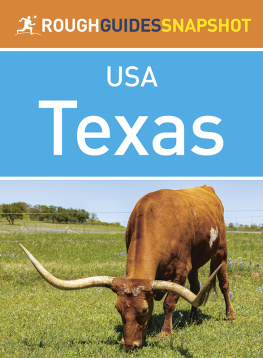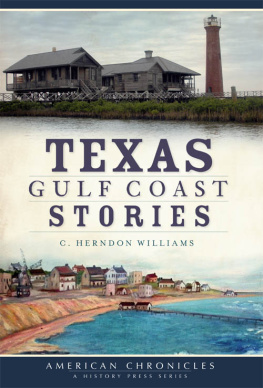

Published by The History Press
Charleston, SC 29403
www.historypress.net
Copyright 2011 by Mike Cox
All rights reserved
Images are from the authors collection unless otherwise noted.
First published 2011
e-book edition 2012
Manufactured in the United States
ISBN 978.1.61423.816.4
Library of Congress Cataloging-in-Publication Data
Cox, Mike, 1948
Big Bend tales / Mike Cox.
p. cm.
print edition ISBN 978-1-60949-330-1
1. Big Bend Region (Tex.)--History--Anecdotes. 2. Big Bend Region (Tex.)--History, Local-Anecdotes. 3. Big Bend Region (Tex.)--Social life and customs--Anecdotes. 4. Big Bend Region (Tex.)--Biography--Anecdotes. I. Title.
F392.B54C69 2011
976.493--dc23
2011027999
Notice: The information in this book is true and complete to the best of our knowledge. It is offered without guarantee on the part of the author or The History Press. The author and The History Press disclaim all liability in connection with the use of this book.
All rights reserved. No part of this book may be reproduced or transmitted in any form whatsoever without prior written permission from the publisher except in the case of brief quotations embodied in critical articles and reviews.
Contents
Acknowledgements
Once again, a fatherly shout-out for my daughter Hallie Cox, who scanned the images used in this book. She also used her computer and artistic skills to touch up several of the illustrations. And a special thanks to several Big Bend folks who were particularly helpful during the research and writing of this book: Melleta R. Bell, senior archivist at Sul Ross State Universitys Archives of the Big Bend; Center for Big Bend Studies archaeologist Roger Boren and center director Andy Cloud; historian and former West Texas sheriff Glenn Willeford; MacGuire Ranch foreman David Williams; and writer/history buff Jim Wilson (also a former sheriff.)
Introduction
Its hard to believe, thinking back, how much mental effort it must have taken me not to look excited the first time my editor on the San Angelo Standard-Times said that he needed me to go to Alpine to handle several story assignments.
Youre going to pay me to go to the Big Bend? Of course, I only thought that; I didnt say it. In the 1960s, touchy-feely management techniques had not yet entered the newsroom. The boss was the boss. Besides, not yet even nineteen, I had to try to act as worldly as possible. Betraying my delight in getting to travel to Alpine in a company vehicle and with expenses paid would not look good.
I had passed through Alpine several times, traveling with my grandparents from Austin to El Paso and back, but other than a visit to old Fort Davis in 1955 and again nine years later, I had not spent much time in the Texas high country until the San Angelo daily hired me in 1967. Happily, I have been back many times since then, variously on someone elses nickel or mine, but never often enough.
While Alpine, Fort Davis and Marfa are definitely part of the Big Bend, the three county seats are really only the scenic gateways to the magnificent country that stretches one hundred miles and more to the souththe mountains and vast desert inside the great bend of the Rio Grande that gave the region its name. In doing research for this book, I ran across this hard-to-improve-on early description, written by former Texas Ranger Andrew Jackson Sowell at his camp in the Chinati Mountains in the winter of 1918: This is a Big Bend country sure enough. From a short distance below El Paso the Rio Grande curves around to Langtry like a bent bow for 200 miles or more, the Southern Pacific Railroad being the string to the bow.
Big Bend Tales is a collection of forty-two true tales about Big Bend people and places, from the great Comanche Trail that cut through the region to the story of an eccentric big-time author who, late in his life, decided to abandon the man-made canyons of New York for a mountainside home overlooking Alpine. As with West Texas Tales, my first book in this series, I have focused on lesser-known or never-published stories. Given my love of the Big Bend, it was a fun book to put together, my only frustration being that a lot of good stories had to be left untold.
Im not the first person in my family to be fascinated with the Big Bend. My late grandfather, L.A. Wilke, also a newspaperman turned freelance writer, spent some time in the Big Bend in the 1920s and 30s when it was far less knownand visitedthan it is today.
On our way back to Austin from a visit with my aunt and uncle in El Paso in the summer of 1964, I talked Granddad into making a slight detour to Fort Davis so I could meet writer-historian Barry Scobee and get a copy of his latest book, Fort Davis Texas 15831960. Granddad had known Scobee for years and easily got me an audience with him. Beyond that, he shelled out six dollars for the book. Long out of print, its now worth several hundred dollars, but bearing this inscription, to me its priceless: Autographed with pleasure for Mike Cox, an up and coming young historian, to whom, Best wishes, Barry Scobee at old Fort Davis Aug. 11, 1964.
No one could accuse me of being a young historian anymore, but at least I dont have to hide my excitement any time I get an opportunity to visit the Big Bend.
Indians
THE COMANCHE TRAIL
Climbing to well-known vantage points in the mountains, the lookouts cut brush, stack it and begin their vigil. Each night, as they look anxiously to the northeast, the September moon rises later and larger, finally hanging as big as a cartwheel over the rugged peaks of the Big Bend country. In the full moons silver light, the watchers can see to the far horizon.
One night, the northernmost sentinel makes the first sighting. In the distance, where the night before there had been nothing, it seems as if the stars have settled on the grounda constellation of tiny, flickering lights. Campfires.
Quickly, the lookout ignites his greasewood pyre, and flames shoot into the clear, dry air. The watcher on the next peak sees the fire and lights his brush pile to alert the lookout on the next height. Soon, all across the Big Bend, down to the Rio Grande and on into Mexico, the word has spread: the Comanches are coming.
Beginning in the 1700safter they acquired horses and learned to use them so well that they came to be called the finest light cavalry in the worldComanche warriors annually raided south of the Rio Grande under a full September moon, when the grass grew high and the water holes stood full. The Comanches called it the time of the Mexican Moon. The people on the frontier of Texas and northern Mexico called it the time of the Comanche Moon.

Comanche Springs at Fort Stockton was an important water hole on the Comanche Trail until the soldiers came.
The Comanche Trail was west Texass first major transportation routea long, dusty trace dug deep over the generations by thousands of hooves, dampened each year with tears and blood. From what is now Kansas in the upper reaches of the land once known as Comancheria, the trailactually a series of trails, followed by various bandsled one thousand miles to the south, plunging like a Comanche lance straight into Mexicos poorly defended northern frontier.
Next page






